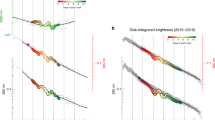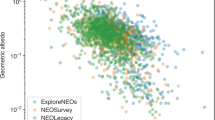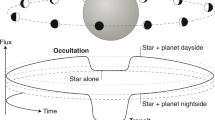Abstract
The detection of massive planets orbiting nearby stars has become almost routine1,2, but current techniques are as yet unable to detect terrestrial planets with masses comparable to the Earth's. Future space-based observatories to detect Earth-like planets are being planned. Terrestrial planets orbiting in the habitable zones of stars—where planetary surface conditions are compatible with the presence of liquid water—are of enormous interest because they might have global environments similar to Earth's and even harbour life. The light scattered by such a planet will vary in intensity and colour as the planet rotates; the resulting light curve will contain information about the planet's surface and atmospheric properties. Here we report a model that predicts features that should be discernible in the light curve obtained by low-precision photometry. For extrasolar planets similar to Earth, we expect daily flux variations of up to hundreds of per cent, depending sensitively on ice and cloud cover as well as seasonal variations. This suggests that the meteorological variability, composition of the surface (for example, ocean versus land fraction) and rotation period of an Earth-like planet could be derived from photometric observations. Even signatures of Earth-like plant life could be constrained or possibly, with further study, even uniquely determined.
This is a preview of subscription content, access via your institution
Access options
Subscribe to this journal
Receive 51 print issues and online access
$199.00 per year
only $3.90 per issue
Buy this article
- Purchase on Springer Link
- Instant access to full article PDF
Prices may be subject to local taxes which are calculated during checkout



Similar content being viewed by others
References
Marcy, G. W., Cochran, W. D. & Mayor, M. in Protostars and Planets IV (eds Mannings, V., Boss, A. P., Russell, S. S.) 1285–1311 (Univ. Arizona Press, Tucson, 2000).
Butler, R. P., Marcy, G. W., Williams, E., McCarthy, C. & Dopsanjh, P. Attaining Doppler precision of 3 m s-1. Proc. Astron. Soc. Pacif. 108, 500–509 (1996).
Beichman, C. A., Woolf, N. J. & Lindensmith, C. A. The terrestrial planet finder (TPF). NASA/JPL Publ. 99-3, 1–22 (1999).
Darwin the infrared space interferometer—concept and feasibility study report. Technical Report ESA-SCI(2000)12, 1–85 (European Space Agency, 2000).
Nisenson, P. & Papaliolios, C. Detection of earth-like planets using apodized telescopes. Astrophys. J. 548, L201–205 (2001).
Spergel, D. N. A new pupil for detecting extrasolar planets. Appl. Optics (submitted); also preprint astro-ph/0101142 at 〈http://xxx.lanl.gov〉 (2001).
Schindler, T. L. & Kasting, J. F. Synthetic spectra of simulated terrestrial atmospheres containing possible biomarker gases. Icarus 145, 262–271 (2000).
Brown, T. M., Charbonneau, D., Gilliland, R. L., Noyes, R. W. & Burrows, A. Hubble Space Telescope time-series photometry of the transiting planet of HD 209458. Astrophys. J. 552, 699–709 (2001).
Hapke, B. Theory of Reflectance and Emittance Spectroscopy (Cambridge Univ. Press, Cambridge, 1993).
Bukata, R. P., Jerome, J. H., Kondratyev, K. Ya. & Pozdnyakov, D. V. Optical Properties and Remote Sensing of Inland and Coastal Waters 37–102 (CRC Press, New York, 1995).
Vokrouhlicky, D. & Farinella, P. Specular reflection of sunlight from wavy ocean surfaces and the albedo effect on satellite orbits I. A statistical model. Astron. Astrophys. 293, 307–322 (1995).
Jerome, J. H., Bukata, R. P. & Bruton, J. E. Utilizing the components of vector irradiance to estimate the scalar irradiance in natural waters. Appl. Optics 27, 4012–4018 (1988).
Kirk, J. T. O. Volume scattering function, average cosines, and the underwater light field. Limnol. Oceanogr. 36, 455–467 (1991).
Bricaud, A., Babin, M., Morel, A. & Claustre, H. Variability in the chlorophyll-specific absorption coefficients of natural phytoplankton: analysis and parameterization. J. Geophys. Res. 100, 13321–13332 (1995).
Kondratyev, K. Ya. Radiation in the Atmosphere (Academic, New York, 1969).
Verbiscer, A. J. & Veverka, J. Scattering properties of natural snow and frost: comparison with icey satellite photometry. Icarus 88, 418–428 (1990).
Myneni, R. B. et al. Optical remote sensing of vegetation: modeling, caveats, and algorithms. Remote Sens. Environ. 51, 169–188 (1995).
Jacquemound, S., Baret, F. & Hanocq, J. F. Modeling spectral and bidirectional soil reflectance. Remote Sens. Environ. 41, 123–132 (1992).
Woessner, P. & Hapke, B. Polarization of light scattered by clover. Remote Sens. Environ. 21, 243–261 (1987).
DeFries, R. S. & Townshend, J. R. G. NDVI-derived land cover classification at a global scale. Int. J. Remote Sens. 15, 3567–3586 (1994).
Hovenier, J. W. & Hage, J. I. Relations involving the spherical albedo and other photometric quantities of planets with thick atmospheres. Astron. Astrophys. 214, 391–401 (1989).
Rossow, W. B. & Schiffer, R. A. ISCCP cloud data products. Bull. Am. Meteorol. Soc. 72, 2–20 (1991).
Goode, P. R. et al. Earthshine Observations of the Earth's Reflectance. J. Geophys. Res. Lett. 28, 1671–1674 (2001).
Sagan, C., Thompson, W. R., Carlson, R., Gurnett, D. & Hord, C. A. Search for life on earth from the Galileo spacecraft. Nature 365, 715 (1993).
Acknowledgements
We thank the members of the Ball Aerospace Terrestrial Planet Finder team, B. Soden, A. Broccoli and G. Williams for discussions, and B. Soden for assistance with the ISCCP database. We wish to thank W. B. Rossow, the Goddard Institute for Space Studies, the Goddard Space Flight Center, and NASA for the production and distribution of this data set. E.B.F. would like to acknowledge support under a National Science Foundation Graduate Fellowship and S.S. is supported by the W. M. Keck Foundation.
Author information
Authors and Affiliations
Corresponding author
Rights and permissions
About this article
Cite this article
Ford, E., Seager, S. & Turner, E. Characterization of extrasolar terrestrial planets from diurnal photometric variability. Nature 412, 885–887 (2001). https://doi.org/10.1038/35091009
Received:
Accepted:
Issue Date:
DOI: https://doi.org/10.1038/35091009
This article is cited by
Comments
By submitting a comment you agree to abide by our Terms and Community Guidelines. If you find something abusive or that does not comply with our terms or guidelines please flag it as inappropriate.



